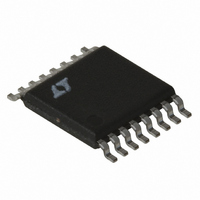LT1940EFE#TR Linear Technology, LT1940EFE#TR Datasheet - Page 11

LT1940EFE#TR
Manufacturer Part Number
LT1940EFE#TR
Description
IC REG SW DUAL 1.4A STDN 16TSSOP
Manufacturer
Linear Technology
Type
Step-Down (Buck)r
Datasheet
1.LT1940EFEPBF.pdf
(20 pages)
Specifications of LT1940EFE#TR
Internal Switch(s)
Yes
Synchronous Rectifier
No
Number Of Outputs
2
Voltage - Output
1.25 ~ 22 V
Current - Output
1.4A
Frequency - Switching
1.1MHz
Voltage - Input
3.6 ~ 25 V
Operating Temperature
-40°C ~ 85°C
Mounting Type
Surface Mount
Package / Case
16-TSSOP Exposed Pad, 16-eTSSOP, 16-HTSSOP
Lead Free Status / RoHS Status
Contains lead / RoHS non-compliant
Power - Output
-
Available stocks
Company
Part Number
Manufacturer
Quantity
Price
Table 2. Low-ESR Surface Mount Capacitors
Vendor
Taiyo Yuden
AVX
Kemet
Sanyo
Panasonic
TDK
Catch Diode
Use a 1A Schottky diode for the catch diode (D1 in
Figure 2). The diode must have a reverse voltage rating
greater than the maximum input voltage. The ON Semi-
conductor MBRM120LT3 (20V) and MBRM130LT3 (30V)
are good choices; they have a tiny package with good
thermal properties. Many vendors have surface mount
versions of the 1N5817 (20V) and 1N5818 (30V) 1A
Schottky diodes such as the Microsemi UPS120 that are
suitable.
APPLICATIO S I FOR ATIO
V
IN2
> 3V
V
V
IN
IN
Type
Ceramic X5R, X7R
Ceramic X5R, X7R
Tantalum
Tantalum
Ta Organic
Al Organic
Ta or Al Organic
Al Organic
Ceramic X5R, X7R
V
MAX V
V
MAX V
MINIMUM VALUE FOR V
BOOST
BOOST
U
V
BOOST
V
BOOST
IN
– V
D2
– V
IN
SW
SW
BOOST
LT1940
BOOST
LT1940
GND
GND
V
U
V
IN
V
V
IN2
OUT
IN2
+ V
+ V
SW
SW
OUT
(3a)
IN
(3c)
IN2 =
3V
W
Series
TPS
T491,T494,T495
T520
A700
POSCAP
SP CAP
C3
C3
Figure 3. Generating the Boost Voltage
D2
1940 F03
U
V
OUT
V
OUT
Boost Pin Considerations
The capacitor and diode tied to the BOOST pin generate a
voltage that is higher than the input voltage. In most cases
a 0.1 F capacitor and fast switching diode (such as the
CMDSH-3 or FMMD914) will work well. Figure 3 shows
three ways to arrange the boost circuit. The BOOST pin
must be more than 2.5V above the SW pin for full effi-
ciency. For outputs of 3.3V and higher the standard circuit
(Figure 3a) is best. For outputs between 2.8V and 3.3V,
use a small Schottky diode (such as the BAT-54). For lower
output voltages the boost diode can be tied to the input
(Figure 3b). The circuit in Figure 3a is more efficient
because the BOOST pin current comes from a lower
voltage source. Finally, as shown in Figure 3c, the anode
of the boost diode can be tied to another source that is at
least 3V. For example, if you are generating 3.3V and 1.8V
and the 3.3V is on whenever the 1.8V is on, the 1.8V boost
diode can be connected to the 3.3V output. In any case,
you must also be sure that the maximum voltage at the
BOOST pin is less than the maximum specified in the
Absolute Maximum Ratings section.
>V
IN
+ 3V
V
V
V
IN2
IN
IN
V
MAX V
MAX V
MAX V
MINIMUM VALUE FOR V
BOOST
V
BOOST
V
BOOST
BOOST
D2
D2
IN
– V
IN
SW
BOOST
LT1940
BOOST
LT1940
– V
GND
GND
2V
V
SW
IN2
V
IN
IN
SW
SW
V
LT1940/LT1940L
IN2
(3b)
(3d)
IN2 =
V
IN
+ 3V
C3
1940 F03
V
V
OUT
OUT
11
1940fa













